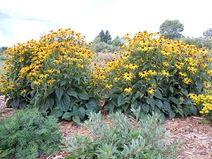Rudbeckia hirta
| Rudbeckia hirta | |
 | |
| Light: | |
| Moisture: | |
| Hardiness: | 4 |
| Soil pH: | 5.6-8.4 |
| Height: | 7' |
| Width: | 2' |
| Blooms: | Mid Summer-Mid Fall |
| Native to: | |
| Medicinal Rating: | |
| Tea: | Yes |
Rudbeckia hirta (common name: black eyed susan)
One of America’s most beloved wildflowers, Black-Eyed Susans serve as the official state flower for Maryland and inspired the University of Southern Mississippi colors. The flowers are popular with short and long-tongued pollinators, the leaves are an important food for Silvery Checkerspot butterfly larva, and the seeds are feasted upon by goldfinches. The chocolaty-centered discs emanate bright yellow rays to humans but appear as three-ringed bull’s eyes to pollinators as demonstrated by botanists in 1969 who used the flower as the primary subject in ultraviolet light research highlighting the nectar guiding markings. While it shares the same moniker with other flowers, likely from a 1720s poem of a black-eyed woman searching for her Sweet William, its prestigious botanical name that uniquely identifies the plant honors Olof Rudbeck, the teacher of Carl Linnaeus who created the botanical naming convention. The flowers flourish in wide ranges of soils, except poorly draining soils, and tolerates drought due to copious root hairs that excel at water absorption while also controlling erosion. The flower may act as an annual in some places but typically develops in the first season and flowering in the second before freely self-seeding with seeds that remain viable for decades. A poultice from this flower was used by the Chippewas for snake bites and the Menominee and Pottawatomie used this medicinal herb as a diuretic.
One of America’s most beloved wildflowers, Black-Eyed Susans serve as the official state flower for Maryland and inspired the University of Southern Mississippi colors. The flowers are popular with short and long-tongued pollinators, the leaves are an important food for Silvery Checkerspot butterfly larva, and the seeds are feasted upon by goldfinches. The chocolaty-centered discs emanate bright yellow rays to humans but appear as three-ringed bull’s eyes to pollinators as demonstrated by botanists in 1969 who used the flower as the primary subject in ultraviolet light research highlighting the nectar guiding markings. While it shares the same moniker with other flowers, likely from a 1720s poem of a black-eyed woman searching for her Sweet William, its prestigious botanical name that uniquely identifies the plant honors Olof Rudbeck, the teacher of Carl Linnaeus who created the botanical naming convention. The flowers flourish in wide ranges of soils, except poorly draining soils, and tolerates drought due to copious root hairs that excel at water absorption while also controlling erosion. The flower may act as an annual in some places but typically develops in the first season and flowering in the second before freely self-seeding with seeds that remain viable for decades. A poultice from this flower was used by the Chippewas for snake bites and the Menominee and Pottawatomie used this medicinal herb as a diuretic.
Propagation: Seed - sow April in a greenhouse. Only just cover the seed. Germination should take place within 2 weeks, prick out the seedlings into individual pots when they are large enough to handle and plant them out in the summer[K]. The seed can also be sown in situ[1].
Cultivation: Succeeds in an ordinary medium soil in sun or shade[1]. Requires a moist soil[2]. Prefers a well-drained soil[3].
Dormant plants are hardy to about -25°c[4].
This species is a biennial or short-lived perennial[5].
Some named forms have been selected for their ornamental value[5].
Members of this genus are rarely if ever troubled by browsing deer[6].
Range: N. America. An occasional garden escape in Britain[7].
Habitat: Disturbed soils in Texas[8].
Medicinal: An infusion of the roots has been used in the treatment of colds, dropsy and worms in children[9]. A warm infusion of the root has been used as a wash on sores and snake bites[9]. The ooze from the roots has been used as drops to treat earaches[9].
Usage: A yellow dye is obtained from the flowers[9].
Pollinators: Bees, hoverflies
Soil: Can grow in light, medium, and heavy soils.
Wind: Tolerates strong winds
Seed Ripens: Late Summer-Mid Fall
Flower Type: Hermaphrodite
Known Hazards: This plant is reputed to be poisonous to cattle, sheep and pigs[10].
Links
- Rudbeckia hirta - Plants for a Future
- Rudbeckia hirta - USDA Plant Profile
References
- ↑ 1.0 1.1 Sanders, Thomas. Popular Hardy Perennials. Collingridge, 1926.
- ↑ Chittendon, Fred. RHS Dictionary of Plants. Oxford University Press, 1951.
- ↑ Brickell, Christopher. The RHS Gardener's Encyclopedia of Plants and Flowers. Dorling Kindersley Publishers, 1990.
- ↑ Phillips, Roger and Martyn Rix. Perennials - The Definitve Reference. Pan Books, 1991.
- ↑ 5.0 5.1 Huxley, Anthony. The New Royal Horticultural Society Dictionary of Gardening. MacMillan Press, 1992.
- ↑ Thomas, Graham. Perennial Garden Plants. J. M. Dent & Sons, 1990.
- ↑ Clapham, Arthur and Tom Tootin, Edmund Warburg. Flora of the British Isles. Cambridge University Press, 1962.
- ↑ Diggs, George and Barney Lipscomb. Illustrated Flora of North Central Texas. Botanical Research Institute, 1999.
- ↑ 9.0 9.1 9.2 9.3 Moerman, Daniel. Native American Ethnobotany. Timber Press, 1998.
- ↑ Arnberger, Leslie. Flowers of the Southwest Mountains. Southwestern Monuments, 1968.